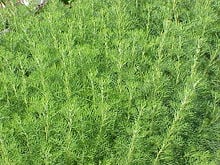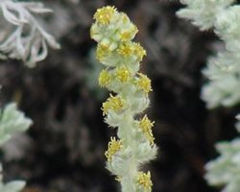Artemisia (genus)
| Artemisia | ||||||||||||
|---|---|---|---|---|---|---|---|---|---|---|---|---|
 Artemisia dracunculus
| ||||||||||||
| Scientific classification | ||||||||||||
| ||||||||||||
|
See text |
Artemisia is a large, diverse genus of mostly perennial and aromatic herbs and shrubs in the daisy family Asteraceae, characterized by alternate leaves and small flower heads. Many of the perhaps 400 species in the genus are valued for their essential oils or as ornamentals. Well-known species include wormwood, mugwort, tarragon, and sagebush.
Many of the plant components that are so vital to the the survival and reproduction of the plants—leaves, flowers, volatile oils—also provide a larger value for the ecosystem and for humans. The leaves and essential oils are used medicinally, including the production of an anti-malarial compound from Artemisia annua. Various species are used for culinary purposes, with A. absinthium used in vermouth and absinthe, and A. dracunculus (tarragon) popular in French cuisine. Although many species are wind-pollinated, there is evidence of insect pollination for some species (Tkach et al. 2007), with the flowers offering nectar to the insects in exchange for pollination. The attractive foliage and colorful flower-heads of some species make them desirable ornamental plants.
Description
Asteraceae family
The family Asteraceae or Compositae, to which Artemisia belongs, is known as the aster, daisy, or sunflower family. It is the largest family of flowering plants in terms of number of species. According to the Royal Botanical Gardens of Kew, the family comprises more than 1,600 genera and 23,000 species. The name 'Asteraceae' is derived from the type genus Aster and refers to the star-shaped flower head of its members, epitomized well by the daisy. "Compositae," an older but still valid name (McNeill et al. 2006), means "composite" and refers to the unique inflorescence[1] (described below).
Asteraceae is a taxon of dicotyledonous flowering plants. In addition to the daisy and members of Artemisia, other well-known members of the family include lettuce, chicory, globe artichoke, safflower, dandelion, ragwort, and sunflower.
Plants belonging to the AsteraceaeCite error: Closing </ref> missing for <ref> tag[2]
- "tiny silver ball-like flowers"[3]
- Artemisia schrenkiana Ledeb.
- Artemisia scoparia Waldst. & Kit. – Redstem Wormwood
- Artemisia scopiformis Ledeb.
- Artemisia scopulorum Gray – Alpine Sagebrush, Dwarf Sagebrush
- Artemisia scotina Nevski
- Artemisia senjavinensis Bess. – Arctic Wormwood
- Artemisia selengensis Turcz. ex Besser
- Artemisia semiarida (Krasch. & Lavrenko) Filatova
- Artemisia senjavinensis Besser
- Artemisia sericea Weber ex Stechm.
- Artemisia serotina Bunge
- Artemisia serrata Nutt. – Sawtooth Wormwood
- Artemisia spinescens (syn. Picrothamnus desertorum) – Bud Brush, Bud Sage
- Artemisia sieversiana Willd.
- Artemisia skorniakowii C.G.A.Winkl.
- Artemisia sogdiana Bunge
- Artemisia songarica Schrenk
- Artemisia spicigera K.Koch
- Artemisia splendens Willd.
- Artemisia stelleriana Bess. – Hoary Mugwort
- Artemisia stenocephala Krasch. ex Poljak.
- Artemisia stenophylla Kitam.
- Artemisia stolonifera (Maxim.) Kom.
- Artemisia subarctica Krasch.
- Artemisia subchrysolepis Filatova
- Artemisia sublessingiana Krasch. ex Poljakov
- Artemisia subsalsa Filatova
- Artemisia subviscosa Turcz. ex Besser
- Artemisia succulenta Ledeb.
- Artemisia suksdorfii Piper – Coastal Wormwood
- Artemisia sylvatica Maxim.
- Artemisia szowitziana (Besser) Grossh.
- Artemisia tanacetifolia L.
- Artemisia taurica Willd.
- Artemisia tenuisecta Nevski
- Artemisia terrae-albae Krasch.
- Artemisia tianschanica Krasch. ex Poljak.
- Artemisia tilesii Ledeb. – Tilesius' Wormwood
- Artemisia tomentella Trautv.
- Artemisia tournefortiana Rchb.
- Artemisia transbaicalensis Leonova
- Artemisia transiliensis Poljakov
- Artemisia trautvetteriana Besser
- Artemisia tridentata Nutt. – Big Sagebrush, Blue Sage, Black Sage, Basin Sagebrush
- Artemisia triniana Besser
- Artemisia tripartita Rydb. – Threetip Sagebrush
- Artemisia turanica Krasch.
- Artemisia turcomanica Gand.
- Artemisia umbelliformis Lam. – Alps Wormwood
- Artemisia unalaskensis Rydb.
- Artemisia vachanica Krasch. ex Poljak.
- Artemisia valida Krasch. ex Poljak.
- Artemisia verlotiorum Lamotte – Chinese Wormwood
- Artemisia viridis Willd.
- Artemisia vulgaris L. – Mugwort
Notes
- ↑ Inflorescences: How flowers are arranged on the stem, The Seed Site. Retrieved June 11, 2008.
- ↑ Silver Mound Artemisia, Angel's Hair, Philippe Faucon. Retrieved May 1, 2008.
- ↑ Heritage Perennial Profile, Valleybrook International Ventures Inc. Retrieved May 1, 2008.
ReferencesISBN links support NWE through referral fees
- Golden Harvest Organics (GHO). 2008. Companion planting: Wormwood or Artemisia. Golden Harvest Organics. Retrieved April 17, 2008.
- Judd, W. S., C. S. Campbell, E. A. Kellogg, and P. F. Stevens. 1999. Plant Systematics: A Phylogenetic Approach. Sunderland, MA: Sinauer Associates. ISBN 0878934049.
- McNeill, J. et al. 2006. International Code of Botanical Nomenclature. International Association of Plant Taxonomy (IAPT). Retrieved April 11, 2008.
- Mucciarelli, M., and M. Maffei. 2002. Introduction to the genus. Pages 1-50 in C. W. Wright, Artemisia. Medicinal and aromatic plants—industrial profiles, v. 18. London: Taylor & Francis. ISBN 0415272122.
- Tkach, N.V., M. H. Hoffmann, M. Roser, A. A. Korobkov, and K. B. von Hagan. 2007. Parallel evolutionary patterns in multiple lineages of arctic Artemisia L. (Asteraceae). Evolution 62(1): 184-198. Retrieved April 18, 2008.
- Watson, L. E., P. L. Bates, T. M. Evans, M. M. Urwin, and J. R. Estes. 2002. Molecular phylogeny of subtribe Artemisiinae (Asteraceae), including Artemisia and its allied and segregate genera. BioMed Central Evolutionary Biology 2:17. Retrieved April 17, 2008.
External references
- Germplasm Resources Information Network: Artemisia. Retrieved April 17, 2008.
- Flora Europaea: Artemisia. Retrieved April 17, 2008.
- Flora of China: Artemisia species list. Retrieved April 17, 2008.
Credits
New World Encyclopedia writers and editors rewrote and completed the Wikipedia article in accordance with New World Encyclopedia standards. This article abides by terms of the Creative Commons CC-by-sa 3.0 License (CC-by-sa), which may be used and disseminated with proper attribution. Credit is due under the terms of this license that can reference both the New World Encyclopedia contributors and the selfless volunteer contributors of the Wikimedia Foundation. To cite this article click here for a list of acceptable citing formats.The history of earlier contributions by wikipedians is accessible to researchers here:
The history of this article since it was imported to New World Encyclopedia:
Note: Some restrictions may apply to use of individual images which are separately licensed.
